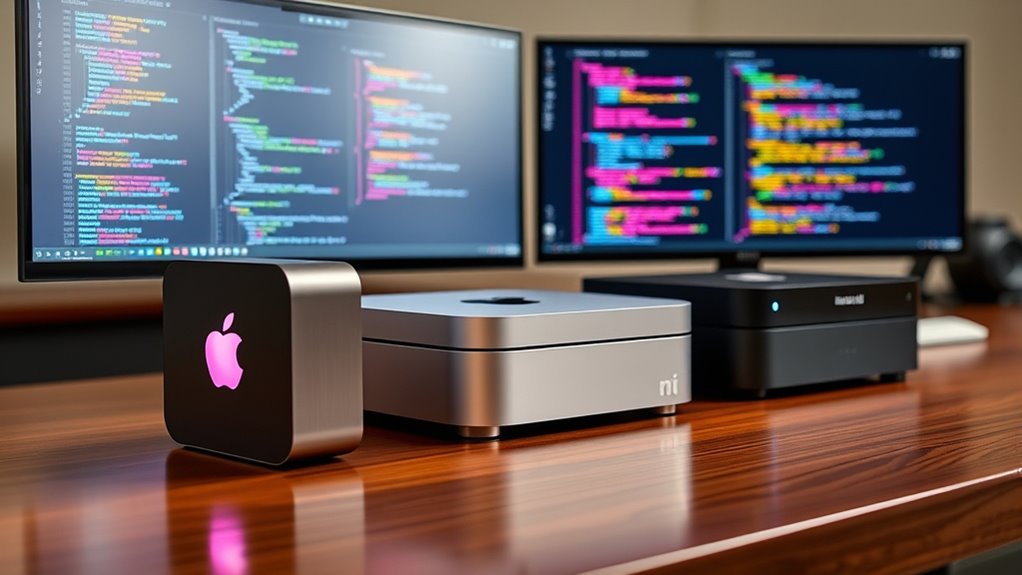If you’re looking to boost your coding performance in 2025, I recommend considering the latest Mac minis with the M4 and M4 Pro chips. The M4 model offers a compact, powerful option for most dev tasks, while the M4 Pro handles demanding workloads with up to 64GB RAM and support for multiple high-res displays. For advanced development needs, these models are game-changers—keep exploring to find out which one fits your setup best.
Key Takeaways
- The M4 Pro Mac mini offers the highest performance with up to 64GB RAM, ideal for demanding development tasks and multitasking.
- All models feature compact designs, but the M4 Pro version supports multiple 6K displays, enhancing productivity.
- Configurations with larger SSDs and higher RAM ensure future-proofing and efficient handling of large codebases and virtual machines.
- Extensive connectivity options like Thunderbolt 4 and HDMI facilitate multiple peripherals, monitors, and external storage for a streamlined workflow.
- Choosing between M4 and M4 Pro models depends on workload intensity, with the Pro version best suited for resource-heavy development environments.
Apple 2024 Mac mini Desktop Computer with M4 Chip
If you’re looking for a compact yet powerful desktop for software development, the Apple 2024 Mac mini with M4 chip is an excellent choice. Its 10-core CPU and GPU deliver lightning-fast performance, perfect for multitasking and running demanding apps like Adobe Creative Cloud or Microsoft 365. Despite its small size—just 5×5 inches—it’s packed with features, including 16GB of unified memory and a 512GB SSD. The Mac mini offers versatile connectivity with Thunderbolt, HDMI, and Gigabit Ethernet ports, plus front USB-C and headphone jacks. Seamlessly integrate it into your Apple ecosystem for effortless multitasking, coding, and productivity without sacrificing space or power.
Best For: professionals and developers seeking a compact, powerful desktop that integrates seamlessly with the Apple ecosystem for multitasking, coding, and creative work.
Pros:
- Compact size fits easily on any desk or workspace
- Fast performance with M4 chip, 10-core CPU and GPU
- Excellent connectivity options including Thunderbolt, HDMI, and Gigabit Ethernet
Cons:
- Limited upgradeability due to compact design
- Higher price point compared to some other compact desktops
- 512GB SSD storage may be insufficient for very large files or extensive media libraries
Apple 2024 Mac mini Desktop Computer with M4 Pro chip
The Apple 2024 Mac mini with M4 Pro chip stands out as an ideal choice for software developers who need powerful performance in a compact design. Its small footprint (just 5×5 inches) packs a punch with a 12-core CPU, 16-core GPU, and up to 64GB of unified memory, ensuring smooth multitasking and resource-intensive tasks. The M4 Pro’s hardware-accelerated ray tracing and media engines make handling graphics and video encoding effortless. With multiple Thunderbolt 5 ports supporting up to three 6K displays, it’s perfect for multitasking across multiple screens. Plus, seamless integration with macOS and Apple’s ecosystem makes it a versatile, space-saving powerhouse for developers.
Best For: software developers and creative professionals seeking a compact yet powerful desktop with high-performance capabilities and seamless integration within the Apple ecosystem.
Pros:
- Compact design (5×5 inches) fits easily next to monitors and saves space
- Powerful M4 Pro chip with up to 64GB unified memory for smooth multitasking and resource-intensive tasks
- Supports up to three 6K displays, ideal for multitasking and productivity
Cons:
- Limited upgrade options post-purchase (storage and memory)
- Premium price point may be high for budget-conscious users
- May require additional peripherals for complete setup
Apple 2024 Mac mini Desktop Computer with M4 Chip
Designed for power-packed performance despite its compact size, the Apple 2024 Mac mini with M4 chip is an ideal choice for developers who need a small yet capable workstation. Its tiny 5-inch footprint hides a 10-core M4 processor, 16GB of unified memory, and fast SSD storage. It supports up to three displays at 6K or 5K resolutions, making multitasking seamless. With Thunderbolt 4, USB-C, HDMI, and Gigabit Ethernet ports, connectivity is versatile. Plus, it integrates perfectly with the Apple ecosystem, ensuring smooth workflows with iPhone and iPad. All in all, this mini packs serious power, despite its unassuming size.
Best For: developers and creative professionals seeking a compact, powerful workstation that seamlessly integrates with the Apple ecosystem.
Pros:
- Compact size with a powerful M4 chip and high-performance GPU for demanding tasks.
- Supports up to three high-resolution displays, ideal for multitasking and creative work.
- Versatile connectivity options including Thunderbolt 4, HDMI, and Gigabit Ethernet.
Cons:
- Limited internal storage options starting at 256GB, which may require external solutions for large files.
- Relatively higher cost compared to other compact PCs with similar specs.
- No dedicated graphics card options, relying solely on integrated GPU performance.
Factors to Consider When Choosing the Mac Mini for Software Development

When selecting a Mac Mini for software development, I consider several key factors to guarantee it meets my needs. These include processing power, memory capacity, storage options, connectivity ports, and tool compatibility. Understanding these points helps me choose a model that balances performance and future-proofing.
Processing Power Needs
Choosing the right processing power for your Mac Mini depends largely on the complexity of your development tasks. If you’re compiling large codebases or running virtual machines, a higher-core CPU like a 12-core or more can significantly reduce build times and handle multitasking smoothly. For resource-intensive tools like advanced IDEs or containerized environments, a faster CPU with multiple cores will boost performance. If your work involves machine learning, AI, or media processing, hardware-accelerated features and higher core counts become even more advantageous. However, it’s important to balance processing power with RAM and storage, as insufficient CPU resources can create bottlenecks—even with fast SSDs and ample memory. Matching your CPU to your workload ensures your Mac Mini stays responsive and efficient.
Memory Capacity Limitations
Processing power is just one piece of the puzzle; memory capacity plays a crucial role in guaranteeing smooth development workflows. The Mac mini’s maximum RAM varies: the M4 chip supports up to 24GB or 32GB, while the M4 Pro can reach 64GB. Since upgrading memory after purchase is usually not possible, selecting the right configuration upfront is essential—especially for demanding tasks like multitasking, large codebases, or virtual environments. Insufficient RAM can cause slower compile times, increased reliance on swap memory, and sluggish responsiveness when running multiple tools. For complex development environments or containerized applications, higher memory capacity prevents bottlenecks and maintains efficiency. Investing in ample RAM from the start ensures your Mac mini can handle the workload without performance issues.
Storage Options Flexibility
Selecting the right storage options for your Mac mini is essential for maintaining smooth development workflows. Opting for higher storage capacity, like 1TB or more, ensures you have enough space for large files and applications without constantly deleting or managing storage. SSD options provide faster data transfer speeds, which means quicker load times and more efficient coding sessions. Customizable storage at purchase allows you to tailor your setup to your project needs, avoiding the limitations of base models. Additionally, external storage solutions can supplement internal SSDs, offering extra flexibility for archiving and backups. This expandability can greatly enhance your long-term usability and productivity, giving you the freedom to adapt your storage setup as your development demands grow or change over time.
Connectivity and Ports
When setting up your Mac mini for software development, paying attention to connectivity options is vital to maintaining an efficient workflow. Confirm the device has enough Thunderbolt and USB-C ports to connect multiple peripherals like external drives, monitors, and accessories without hassle. Check if the HDMI port supports high-resolution displays, such as 4K or 6K, to optimize your multi-monitor setup. Fast data transfer is essential, so verify the availability of Gigabit Ethernet or higher speeds for reliable network connectivity. If you work with external audio equipment, verify the presence of a headphone jack and other audio ports. Finally, consider the total number and types of ports to make sure they align with your current devices and future expansion needs, preventing bottlenecks down the line.
Compatibility With Tools
Choosing the right Mac mini for software development means ensuring it supports all the tools and SDKs you rely on daily. I check that it runs essential software like Xcode for iOS and macOS development smoothly. It’s also *important* that it’s compatible with popular programming languages such as Python, Java, and environments like Visual Studio Code. I verify the hardware specifications meet the demands of resource-intensive tasks, like compiling large codebases or running virtual machines. Ensuring the operating system version is compatible with the latest tools and libraries is *crucial* to avoid compatibility issues. *Finally*, I consider connectivity options like Thunderbolt and USB-C, which are necessary for connecting external devices and peripherals, making my development workflow seamless and efficient.
Future-Proofing Potential
To future-proof your investment in a Mac mini for software development, it’s vital to take into account hardware features that can handle upcoming software updates and more demanding tools. Opt for a model with the latest M4 Pro chip to guarantee compatibility and performance longevity. Higher RAM options, like 48GB or 64GB, provide better support for resource-intensive projects and multitasking. Increasing SSD storage capacity allows for scalable data management as your development needs grow, avoiding bottlenecks. Advanced connectivity options such as Thunderbolt 5 future-proof your setup for high-speed peripherals and data transfer. Additionally, robust GPU capabilities ensure your system can handle upcoming graphics-heavy development tasks, keeping you ready for new challenges without needing an immediate upgrade.
Portability vs. Power
Deciding between portability and power is a key factor when selecting a Mac mini for software development. If you often work on the go, a more portable model with fewer ports and lower power consumption suits your needs, making it easy to carry and set up anywhere. Conversely, if your work involves intensive coding, testing, and multitasking, a power-focused Mac mini with high-performance chips and extensive connectivity will serve you better in a fixed workspace. The compact size helps fit the device into tight spaces, but it might limit future upgrades. Ultimately, your choice depends on whether your development tasks are primarily mobile or station-based. Balancing these factors guarantees you select a Mac mini that aligns with your workflow and mobility requirements.
Frequently Asked Questions
How Does the Mac Mini Compare to Other Apple Silicon Macs for Development?
The Mac Mini compares favorably to other Apple Silicon Macs for development, especially with its compact size and powerful M2 or M3 chips. While the MacBook Pro offers portability and the Mac Studio provides extra performance, I find the Mac Mini strikes a great balance—it’s affordable, customizable, and perfect for a dedicated workspace. If you’re looking for a reliable, high-performance machine without breaking the bank, the Mac Mini is a solid choice.
Can the Mac Mini Handle Multiple Virtual Machines Simultaneously?
Yes, the Mac Mini can handle multiple virtual machines at once, especially the newer models with M1 or M2 chips. I’ve run several VMs simultaneously without much trouble, thanks to ample RAM and fast storage. Just make sure your configuration has enough memory—at least 16GB for smooth multitasking. It’s a solid choice for developers needing to juggle various environments without sacrificing performance.
What Are the Upgrade Options for Storage and RAM in These Mac Minis?
You might think the Mac Mini’s upgrades are limited, but there’s more than meets the eye. You can customize storage easily, thanks to the user-accessible SSD slot, and choose from various capacities. However, RAM is soldered onto the motherboard, so it’s non-upgradable. Planning ahead is key—select the right amount of RAM and storage at purchase to future-proof your setup and avoid limitations down the line.
How Suitable Are These Mac Minis for Ios and Android App Development?
These Mac Minis are quite suitable for iOS and Android app development. They pack powerful processors, ample RAM, and fast storage, which helps handle complex code, emulators, and multiple apps simultaneously. While they’re compact, their performance rivals larger machines, making them ideal for development tasks. Plus, macOS’s robust development environment and compatibility with iOS tools make these Mac Minis a smart choice for cross-platform app creation.
Do Mac Minis Support External GPU Configurations for Enhanced Performance?
Yes, Mac Minis can support external GPU configurations, but it’s a bit of a mixed bag. I’d say it’s like adding a turbo boost to your ride—some models handle it well, especially those with Thunderbolt 3 or 4 ports. Keep in mind, not all Mac Minis officially support eGPUs, so I recommend checking compatibility before investing. It can give your development tasks a much-needed kick in the pants.
Conclusion
Choosing the right Mac Mini can truly elevate your coding experience. Imagine finally running complex apps smoothly, just like Sarah, who boosted her startup’s productivity with the M4 Pro model. Whether you’re a beginner or a pro, picking the right specs makes a difference. Don’t settle for less—invest in a machine that grows with you. Your perfect coding partner is out there; all you need to do is choose it.











